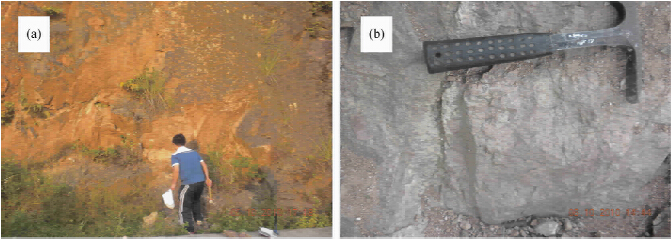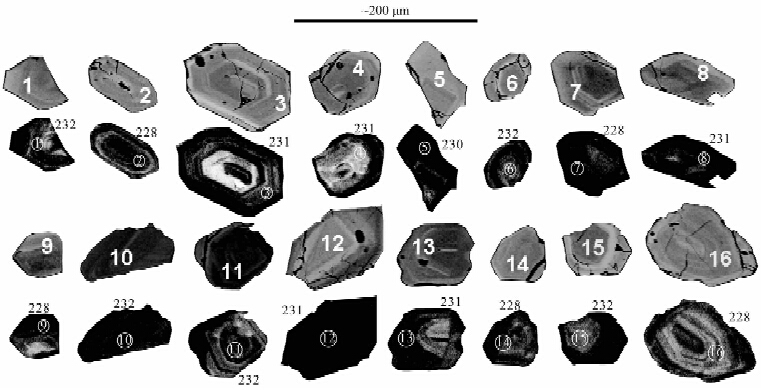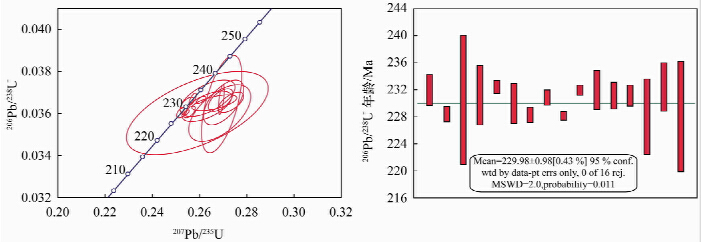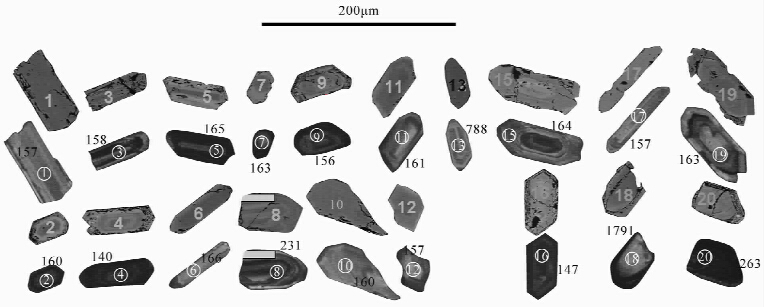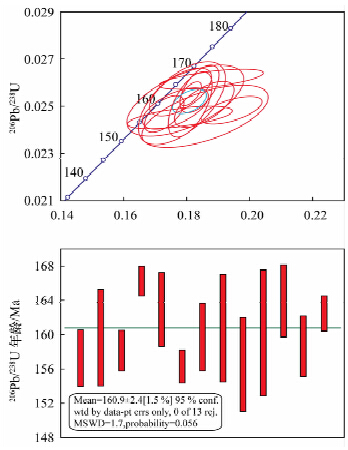Zircon U-Pb Geochronology and Uranium-Production Capacity of the Taoshan Complex in Southern Jiangxi
-
摘要: 桃山复式花岗岩体位于南岭东段北部,区内产有我国最大的花岗岩型铀矿田。宝华山(蔡江)岩体和黄陂岩体是桃山复式岩体中面积最大的两个。前人测得宝华山岩体成岩时代为与铀矿关系更密切的印支期,但是该岩体仅发现个别铀矿床,是否具有更大的产铀潜力还有待探讨;前人测得黄陂岩体与产铀的打鼓寨岩体年龄一致,均为(154±2) Ma,与打鼓寨岩体侵入到黄陂岩体的野外地质现象存在矛盾,有必要进一步厘定其形成年龄。本文利用高精度的激光剥蚀-多接收器电感耦合等离子体质谱法(LA-MC-ICPMS)重新测定了宝华山岩体和黄陂岩体的锆石U-Pb年龄,证实宝华山岩体形成于印支期(229.98±0.98) Ma,重新厘定黄陂岩体形成于燕山早期(160.9±2.4) Ma,略早于产铀的打鼓寨岩体,更符合打鼓寨岩体侵入于黄陂岩体的地质事实。结合前人的研究,本文对桃山复式岩体的岩浆演化序列、构造背景及产铀性进行了讨论,将桃山岩体岩浆演化过程分为五个主要阶段:由印支期的宝华山岩体、燕山早期的黄陂岩体和打鼓寨岩体,以及燕山晚期的罗布里岩体和菜山岩体等组成,不同阶段的岩体对应不同的花岗岩成因类型;推测印支期和燕山期花岗岩的形成均与太平洋板块俯冲造成的伸展拉伸环境有关;指出岩石成因类型是控制花岗岩产铀/不产铀的重要因素,桃山岩体中的S型花岗岩即打鼓寨岩体的产铀能力最强,今后应对花岗岩成因类型控制产铀性的深层原因进一步研究。Abstract: The Taoshan granite complex located at the North-East part of the Nanling region, hosts the largest granite-related uranuim ore field in China. Baohuashan granite and Huangpi granite are two major components of the Taoshan granite complex. The formation age of Baohuashan granite was in the Indosinian period, which is more closely associated with uranuium ore, however, only individual uranium ore has been found in Baohuashan granite. Huangpi and Daguzhai granites have the same age of (154±2) Ma, but this is in conflict with the field geological phenomena, i.e. Huangpi granite was intruded by Daguzhai granite. High precision techniques of Laser Ablation-Multicollector Inductively Coupled Plasma-Mass Spectrometry (LA-MC-ICPMS) have been used to re-determine the emplacement age of these two plutons and the method is reported in this paper. The results indicate that Baohuashan granite was formed in the Indosinian era (229.98±0.98) Ma, and the Huangpi granite was formed in the early Yanshanian era (160.9±2.4) Ma. The emplacement age of Huangpi granite is a little earlier than Daguzhai granite, which is more aligned with the geological facts. Combining with previous studies, the magma evolutionary sequence, tectonic environment and uranium-production capacity of Taoshan complex are discussed. The magma evolutionary sequence of Taoshan complex was classified into five main stages, which is composed of Baohuashan granite in Indonisian, Huangpi and Daguzhai granites in early Yanshanian, Luobuli and Caishan granite in late Yanshanian. Granite formed at deferent stage belongs to deferent genesis type. The formation of Indonian and Yanshanian granite in Taoshan complex was speculated to related extension tectonic environment caused by subduction of pacific plate. We pointed out that the genesis type of granite is a primary controlling factor for uranium-production capacity of granites. The Daguzhai granit, which is an S-type granite, has the greatest uranium-production capacity. There is a need for further study to determine the underlying reasons for the genesis type controlling uranium-production capacity of granite.
-

-
图 1 桃山复式花岗岩体地质简图(修改自Zhao等[5],2011)
Figure 1.
表 1 宝华山岩体(XGbhs1)和黄陂岩体(XGhp1)的LA-MC-ICPMS锆石U-Pb分析结果
Table 1. LA-MC-ICPMS zircon U-Pb data for the Baohuashan granite (XGbhs1) and Huangpi granite (XGhp1)
分析点号 w/(μg·g-1) Th/U 同位素比值 年龄/Ma 谐和度/% Pb Th U 207Pb/206Pb 207Pb/235U 206Pb/238U 207Pb/206Pb 207Pb/235U 206Pb/238U XGbhs1-1 12 93 393 0.24 0.0533 0.2689 0.0366 342.7 241.8 231.9 95 XGbhs1-2 14 100 748 0.13 0.0515 0.2558 0.0361 261.2 231.3 228.4 98 XGbhs1-3 18 201 478 0.42 0.0539 0.2693 0.0364 364.9 242.2 230.6 95 XGbhs1-4 14 214 353 0.61 0.0537 0.2701 0.0365 366.7 242.8 231.2 95 XGbhs1-5 35 233 1954 0.12 0.0509 0.2572 0.0367 235.3 232.4 232.4 99 XGbhs1-6 17 396 281 1.41 0.0525 0.2628 0.0363 309.3 236.9 230.0 97 XGbhs1-7 36 215 1895 0.11 0.0509 0.2523 0.0360 235.3 228.5 228.3 99 XGbhs1-8 39 417 1619 0.26 0.0507 0.2549 0.0365 227.8 230.5 230.9 99 XGbhs1-9 32 268 1512 0.18 0.0512 0.2541 0.0360 255.6 229.9 228.2 99 XGbhs1-10 36 190 1853 0.10 0.0516 0.2605 0.0366 333.4 235.0 231.9 98 XGbhs1-11 30 504 588 0.86 0.0533 0.2692 0.0366 342.7 242.1 232.0 95 XGbhs1-12 68 208 3204 0.06 0.0543 0.2733 0.0365 383.4 245.3 231.2 94 XGbhs1-13 17 220 463 0.48 0.0529 0.2663 0.0365 324.1 239.7 231.2 96 XGbhs1-14 15 201 429 0.47 0.0541 0.2685 0.0360 372.3 241.5 228.0 94 XGbhs1-15 12 115 440 0.26 0.0520 0.2633 0.0367 287.1 237.3 232.5 97 XGbhs1-16 14 156 401 0.39 0.0520 0.2589 0.0360 287.1 233.7 228.1 97 XGhp1-1 29 943 594 1.59 0.0508 0.1728 0.0247 231.6 161.8 157.2 97 XGhp1-2 70 2098 1609 1.30 0.0524 0.1811 0.0251 301.9 169.0 159.7 94 XGhp1-3 29 867 574 1.51 0.0566 0.1941 0.0248 476.0 180.1 158.2 87 XGhp1-4 48 605 2549 0.24 0.0692 0.2096 0.0220 905.6 193.2 140.2 68 XGhp1-5 18 339 845 0.40 0.0594 0.2124 0.0260 588.9 195.5 165.3 83 XGhp1-6 3 104 103 1.01 0.0520 0.1876 0.0261 287.1 174.6 166.4 95 XGhp1-7 16 382 427 0.89 0.0504 0.1779 0.0256 213.0 166.2 163.0 98 XGhp1-8 17 149 982 0.15 0.0515 0.2592 0.0365 261.2 234.0 231.3 98 XGhp1-9 10 326 247 1.32 0.0525 0.1777 0.0245 305.6 166.1 156.3 93 XGhp1-10 9 166 267 0.62 0.0536 0.1855 0.0251 353.8 172.8 159.7 92 XGhp1-11 9 229 252 0.91 0.0514 0.1794 0.0253 261.2 167.5 160.8 95 XGhp1-12 7 191 122 1.57 0.0548 0.1859 0.0246 466.7 173.1 156.5 89 XGhp1-13 24 133 128 1.04 0.0682 1.2212 0.1300 875.9 810.3 788.0 97 XGhp1-14 9 203 412 0.49 0.0514 0.1784 0.0252 257.5 166.7 160.2 96 XGhp1-15 84 2449 2151 1.14 0.0518 0.1840 0.0258 279.7 171.5 164.0 95 XGhp1-16 7 144 157 0.91 0.0702 0.2233 0.0231 1000.0 204.7 147.1 67 XGhp1-17 2 61 91 0.67 0.0512 0.1763 0.0249 253.8 164.8 158.7 96 XGhp1-18 97 216 189 1.15 0.1170 5.1658 0.3204 1910.2 1847.0 1791.5 96 XGhp1-19 44 963 2213 0.44 0.0515 0.1813 0.0255 264.9 169.2 162.6 96 XGhp1-20 5 16 189 0.08 0.0560 0.3215 0.0416 453.8 283.0 262.9 92 -
[1] 黄净白,黄世杰.中国铀资源区域成矿特征[J].铀矿地质, 2005, 21(3): 129-138. http://www.cnki.com.cn/Article/CJFDTOTAL-YKDZ200503001.htm
[2] Min M Z, Fang C, Fayek M. Petrography and genetic history of coffinite and uraninite from the Liueryiqi granite-hosted uranium deposit, SE China [J].Ore Geology Reviews, 2005, 26(3-4): 187-197. doi: 10.1016/j.oregeorev.2004.10.006 http://cn.bing.com/academic/profile?id=1999118418&encoded=0&v=paper_preview&mkt=zh-cn
[3] Zhao K D, Jiang S Y, Chen W F, Chen P R, Ling H F.Zircon U-Pb chronology and elemental and Sr-Nd-Hf isotope geochemistry of two Triassic A-type granites in South China: Implication for petrogenesis and Indosinian transtensional tectonism [J].Lithos, 2013(160-161): 292-306. http://cn.bing.com/academic/profile?id=2008335913&encoded=0&v=paper_preview&mkt=zh-cn
[4] 陈培荣.华南东部中生代岩浆作用的动力学背景及其与铀成矿关系[J].铀矿地质,2004,20(5): 266-270. http://www.cnki.com.cn/Article/CJFDTOTAL-YKDZ200405002.htm
[5] Zhao K D, Jiang S Y, Dong C Y, Chen W F, Chen P R, Ling H F, Zhang J, Wang K X.Uranium-bearing and barren granites from the Taoshan Complex, Jiangxi Province, South China: Geochemical and petrogenetic discrimination and exploration significance [J].Journal of Geochemical Exploration, 2011(110): 126-135. http://cn.bing.com/academic/profile?id=1974734258&encoded=0&v=paper_preview&mkt=zh-cn
[6] Zheng Y F, Shen W Z, Xu G Q, Zhang Z H. Rb-Sr and U-Pb dating of the Daguzhai and Luobuli granitic massifs in South China [J].Chinese Journal of Geochemistry, 1992, 11(2): 97-110. doi: 10.1007/BF02871997 http://cn.bing.com/academic/profile?id=2093849327&encoded=0&v=paper_preview&mkt=zh-cn
[7] 郑永飞,张祖还,沈渭洲.打古寨—罗布里两种不同类型花岗岩的岩石地球化学特征和形成条件探讨[J].南京大学学报(自然科学版), 1986,5(4): 323-331. http://www.cnki.com.cn/Article/CJFDTOTAL-YSKW198604004.htm
[8] 徐夕生,邓平, O’Reilly S Y, Griffin W L,周新民,谭正中.华南贵东杂岩体单颗粒锆石激光探针ICPMS U-Pb定年及其成岩意义[J].科学通报,2003,48(12): 1328-1334. doi: 10.3321/j.issn:0023-074X.2003.12.020 http://epub.cnki.net/kns/detail/detail.aspx?QueryID=4&CurRec=1&recid=&FileName=KXTB200312020&DbName=CJFD2003&DbCode=CJFQ&pr=
[9] 丁兴,陈培荣,陈卫锋,黄宏业,周新民.湖南沩山花岗岩中锆石 LA-ICPMS U-Pb定年:成岩启示和意义[J].中国科学(D辑), 2005, 35(7): 606-616. http://epub.cnki.net/kns/detail/detail.aspx?QueryID=8&CurRec=6&recid=&FileName=JDXK200507001&DbName=CJFD2005&DbCode=CJFQ&pr=
[10] 孙涛,周新民,陈培荣,李惠民,周红英,王志成,沈渭洲.南岭东段中生代强过铝花岗岩成因及其大地构造意义[J].中国科学(D辑),2003,33(12): 1209-1218. doi: 10.3321/j.issn:1006-9267.2003.12.010 http://www.cnki.com.cn/Article/CJFDTOTAL-JDXK200312009.htm
[11] 张敏,陈培荣,黄国龙,谭正中,凌洪飞,陈卫锋.南岭东段龙源坝复式岩体 LA-ICP-MS锆石U-Pb年龄及其地质意义[J].地质学报,2006,80(7): 984-994. http://epub.cnki.net/kns/detail/detail.aspx?QueryID=12&CurRec=1&recid=&FileName=DZXE200607004&DbName=CJFD2006&DbCode=CJFQ&pr=
[12] 王丽娟,于津海,徐夕生,谢磊,邱检生,孙涛.闽西南古田—小陶花岗质杂岩体的形成时代和成因[J].岩石学报,2007, 23(6): 1470-1484. http://www.cnki.com.cn/Article/CJFDTOTAL-YSXB200706021.htm
[13] 孙涛.新编华南花岗岩分布图及其说明[J].地质通报,2006,25(3): 332-337. http://www.cnki.com.cn/Article/CJFDTOTAL-ZQYD200603002.htm
[14] Zhou X M, Sun T, Shen W Z, Shu L, Niu Y.Petrogenesis of Mesozoic granitoids and volcanic rocks in South China: A response to tectonic evolution [J].Episodes, 2006, 29: 26-33. http://cn.bing.com/academic/profile?id=2401031425&encoded=0&v=paper_preview&mkt=zh-cn
[15] Wang Y, FanW, Sun M, Liang X, Zhang Y, Peng T. Geochronological, geochemical and geothermal constraints on petrogenesis of the Indosinian pera-luminous granites in the South China Block: A case study in the Hunan Province [J].Lithos, 2007, 96 (3-4): 475-502. doi: 10.1016/j.lithos.2006.11.010 http://www.sciencedirect.com/science/article/pii/S0024493706003033
[16] 于津海,王丽娟,王孝磊,邱检生,赵蕾.赣东南富城杂岩体的地球化学和年代学研究[J].岩石学报,2007,23(6): 1441-1456. http://www.cnki.com.cn/Article/CJFDTOTAL-YSXB200706019.htm
[17] Sun Y, Ma C, Liu Y, She Z.Geochronological and geochemical constraints on the petrogenesis of late Triassic aluminous A-type granites in southeast China [J].Journal of Asian Earth Sciences, 2011, 42: 1117-1131. doi: 10.1016/j.jseaes.2011.06.007 http://cn.bing.com/academic/profile?id=2087669497&encoded=0&v=paper_preview&mkt=zh-cn
[18] 李万友,马昌前,刘园园.浙江印支期铝质A型花岗岩的发现及其地质意义[J].中国科学(地球科学),2012,42(2): 164-177. http://www.cnki.com.cn/Article/CJFDTOTAL-JDXK201202004.htm
[19] 向庭富,孙涛,陈培荣,王凯兴.闽西北罗古岩岩体印支期年龄的厘定及其岩石成因和构造意义[J].高校地质学报,2013,19(2): 274-292. http://www.cnki.com.cn/Article/CJFDTOTAL-GXDX201302011.htm
[20] 王强,赵振华,简平,熊小林,马金龙,包志伟.武夷山洋坊霓辉石正长岩的锆石SHRIMP U-Pb年龄及其构造意义[J].科学通报, 2003,48(14): 1582-1588. doi: 10.3321/j.issn:0023-074X.2003.14.020 http://epub.cnki.net/kns/detail/detail.aspx?QueryID=16&CurRec=1&recid=&FileName=KXTB200314019&DbName=CJFD2003&DbCode=CJFQ&pr=
[21] Wang Q, Li J W, Jian P, Zhao Z H, Xiong X L, Bao Z W, Xu J F, Li C F, Ma J L.Alkaline syenites in eastern Cathaysia (South China): Link to Permian-Triassic transtension [J].Earth and Planetary Science Letters,2005,230: 339-354. doi: 10.1016/j.epsl.2004.11.023 http://cn.bing.com/academic/profile?id=2077455212&encoded=0&v=paper_preview&mkt=zh-cn
[22] 毛景文,谢桂青,郭春丽,袁顺达,程彦博,陈毓川.华南地区中生代主要金属矿床时空分布规律和成矿环境[J].高校地质学报, 2008,14(4): 510-526. http://www.cnki.com.cn/Article/CJFDTOTAL-GXDX200804007.htm
[23] 张祖还,章邦桐.华南产铀花岗岩及有关铀矿床研究[M].北京:原子能出版社,1991: 258.
[24] 窦小平.华东地区花岗岩类成因类型及其与铀成矿的关系[J].铀矿地质,2004,20(6): 330-336. http://www.cnki.com.cn/Article/CJFDTOTAL-YKDZ200406001.htm
[25] 杜乐天.花岗岩型铀矿文集[M].北京:原子能出版社,1982: 1-404.
[26] 郑永飞,沈渭洲,张祖还.6217铀矿床成因的同位素地质研究[J].矿床地质,1986,5(2): 53-62. http://www.cnki.com.cn/Article/CJFDTOTAL-KCDZ198602007.htm
[27] 张成江.华南几个杂岩体中产铀与非产铀花岗岩的成因及其与铀成矿关系[J].成都理工学院学报,1996,23(4): 31-38. http://www.cnki.com.cn/Article/CJFDTOTAL-CDLG604.004.htm
[28] 陈佑纬,毕献武,胡瑞忠,戚华文.贵东复式岩体印支期产铀和非产铀花岗岩地球化学特征对比研究[J].矿物岩石,2009,29(3): 106-114. http://www.cnki.com.cn/Article/CJFDTOTAL-KWYS200903015.htm
-



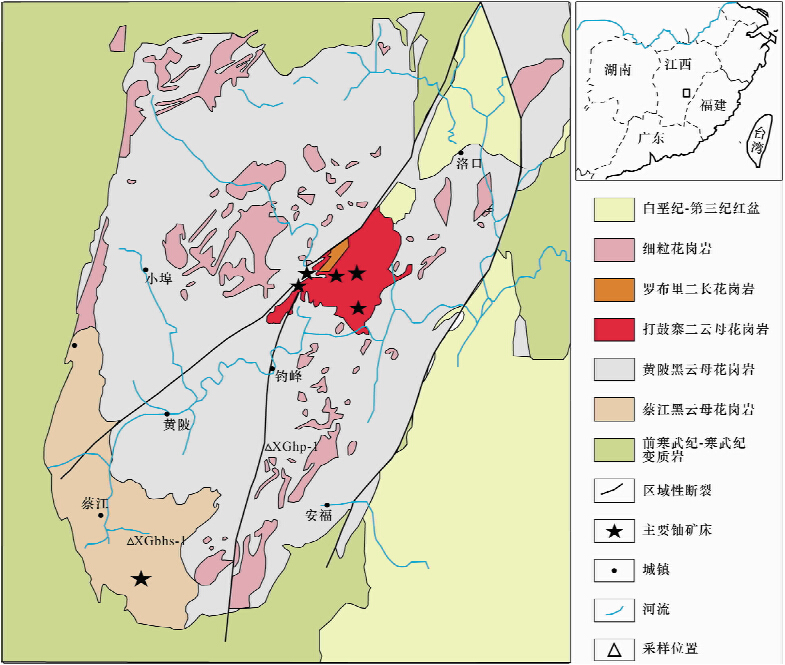
 下载:
下载:
